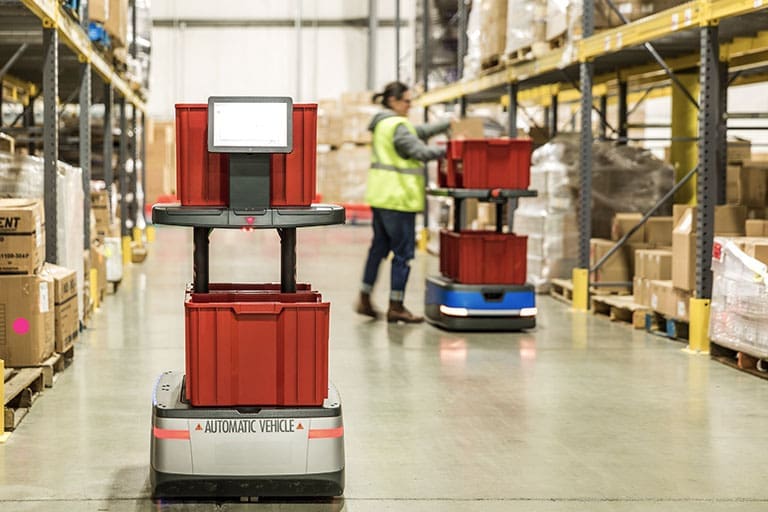Insights to Create a Competitive Advantage
With the volatility businesses have faced in the past few years related to Covid-19, experts are predicting 2023 will continue to present supply chain challenges. With the uncertain economic climate, continued supply chain shortages and an increased focus on both sustainability and technology, 2023 is set to be another transformative year.
From finding ways to take costs out of the value chain, to implementing new automation, companies will have to adapt to stay competitive in an ever-changing North American, and global, market.
In this article we will take a closer look at the top supply chain trends that are expected to shape the industry in 2023. We’ve included insights from some of our supply chain experts who work closely with brands every day to strategize and bring more value to their business.
Dwayne Johnson: Senior Director, Retail, eCommerce and Section 321 Advisor
Ellen McLeod: Director, Strategic Retail Accounts
Amy Lawrie: Director, Strategic Healthcare Accounts
Suhi Nadarajah: Director, Business Development, Technology
1. What supply chain challenges can brands expect to face in 2023?
Inflation and Recession Effecting Supply Chains
Many economists predict that inflation will increase in the coming year. For supply chains, this increases the cost of labour, energy, and transportation. In the US, consumer prices were up 9.1% over the year ended June 2022. This was the largest increase in 40 years according to the U.S. Bureau of Labor Statistics. According to Statistics Canada, the Consumer Price Index (CPI) rose 6.8% year over year in November 2022.
Dwayne Johnson: “As we head into a potential recession, brands will care more about their supply chain costs and where they spend their money. Their spending choices will be heavily based on shortening time to ROI and quantifiable savings.”
Amy Lawrie: “Consumer spending habits are changing as people become more cost conscious and have less disposable income after buying necessities. The high cost of raw materials and supplies is also reducing overall margins for retailers.”
Suhi Nadarajah: “Many retail and technology companies are not hitting their targets. With excess inventory we’re seeing a lot of sales and promotions in Q1 as brands try to clear out stock. In 2023 we’ll see some companies reduce the number of SKUs offered, therefore lowering the number of products and product variation to save on costs, and focus efforts on targeted products.”
The overall sentiment across the retail and supply chain industries is that a recession will cause consumers to cut back spending. Pairing this with the high cost of materials and transportation, brands will be looking for ways they can get more value from their supply chains and overall operating model.
At SCI our long-term forecasts and flexible contingency plans help your business navigate supply chain fluctuations. We help you get a greater return out of your supply chain that creates a competitive advantage by ensuring you can offset the impacts of recessions, labour shortages, etc.
2. What capabilities and services are brands looking for from a 3PL partner in 2023?
Reducing operating costs such as saving on duties and tariffs:
Dwayne Johnson: “Section 321 is the hot topic heading into 2023. As companies look to save on supply chain costs, Section 321 offers a real, tangible way for companies to put money back in their pockets by saving on duty and tariff costs.”
Section 321 is an exemption in the Canada-U.S.-Mexico Agreement that allows small shipments to enter the U.S. duty-free. This offers direct-to-consumer ecommerce retailers an opportunity to reduce their cost per unit through waived or refunded import duties on items that enter Canada bound for U.S. recipients, without affecting the customer’s experience.

By relocating distribution to Canada, retailers can maximize orders by servicing both the U.S. and Canadian markets from a single location. It also enables retailers to reduce their inventory carrying costs and turn products faster, while driving down supply chain costs.
Flexibility and Speed:
Amy Lawrie: “Brands are looking for flexibility from their 3PL partner. Many brands’ marketing teams are changing up their strategies and tactics rapidly and trying various approaches to appeal to their customers. Because of this 3PLs also need to have the ability to adapt quickly and be flexible to their needs.”
Volume increases, new packaging and kitting methods, or new set-up and staging requirements, are easily handled and scaled quickly by SCI’s flexible operations. With our extensive experience and resources, we’re able to use a combination of highly trained personnel, as well as the latest automation and technology solutions to manage and store inventory, pick and pack products, and provide last mile delivery, quickly and efficiently. Our data visibility also allows us to keep a close eye on orders and inventory and adapt as our clients’ businesses evolve.
Strategy and Planning:
Dwayne Johnson: “Collaboration between brands and 3PLs will be important in 2023. Brands look to SCI for help to see where they can get a greater return out of their supply chain. We work with clients to develop a strategic North American fulfillment model that significantly reduces duties and tariffs, consolidates inventory and saves on holding costs.”
Our team supports you from start to finish with strategic planning and consultation to help your brand reduce or eliminate your import duty and tariff costs and find efficiencies throughout your supply chain lifecycle. We eliminate costs and complexities, risks, and complexity through continuous improvement, business intelligence, and leveraging our 3PL best practices.

Business intelligence tools and visibility:
Ellen McLeod: “Brands are looking for better reporting and analytics, easy to access portals, and real-time status updates. This includes visibility to transportation delivery statuses. In addition, customers expect to be able to see exactly when their order will be delivered.”
Suhi Nadarajah: “Brands want more business intelligence tools with good, real-time data, to help them make quicker decisions. They’re also looking to their 3PL to help them understand what the data means, and how it can be used to influence their strategy.”
At SCI we use the latest technology to manage volume fluctuations and offer up-to-date end-to-end visibility of your supply chain data that can be accessed at any time to make decisions more quickly and accurately.

Our progressive business intelligence tools allow brands to better track their supply chain performance and give historical inventory and order data. This allows brands to measure, monitor, and optimize their operations, to make better, more informed data-driven decisions. This visibility will also be passed on to the consumer level, where customers now have high expectations around being able to track their orders.
3. What sort of technology and automation supply chain industry trends will we see in 2023?
Automation
Amy Lawrie: “To reduce the pressure coming from the labour shortage, supply chains will need to continue to adapt with more automation, and goods-to-person technology.”
To reduce dependency on manual process and labor, especially during peak periods of demand, and increase production capacity, supply chains continue to incorporate scalable automation solutions. Robotic technology is getting more advanced, safer, and more affordable, making it more accessible to incorporate into operations to assist workers with warehousing and transportation tasks.
SCI can help manage your high-volume e-commerce logistics with our goods-to-person automation strategies which include box-on-demand, vertical lift modules (VLMs), automated parts storage machines, and collaborative robots. Coupled with our business intelligence and analytics tools, our automation technology helps optimize production capacity, improve order accuracy, and increase operational efficiency, saving on your bottom line.
AI and IoT
Artificial intelligence and machine learning will become a driving force for maximizing efficiency of systems and operations in supply chains. This will involve a collaborative approach of humans working with AI to improve operational environments.
Suhi Nadarajah: “The rise of AI will make its way further into supply chain technology. AI can help create better models for route optimization, picking and packing optimization, etc. The Internet of Things (IoT) will also continue to be important used in supply chains in a variety of ways to improve efficiency and visibility.”
The Internet of Things (IoT) refers to the network of physical objects, such as devices, vehicles, buildings, and other items embedded with sensors, software, and connectivity which enables these objects to collect and exchange data. IoT provides up-to-date transparency and information about product location, speed of movement, estimated arrival, etc. This helps uncover delays, bottlenecks, and disruptions in the supply chain, which organizations can improve to save costs, raise service levels, and optimize systems.
4. How will a focus on sustainability effect supply chain industry trends?
Amy Lawrie: “Companies whose branding is closely tied to sustainability and green initiatives will look to work with 3PLs that share these same values and have sustainable practices. As a 3PL its important for us to demonstrate and highlight our sustainable practices and in turn, help strategize how we can better help these companies achieve their sustainability goals.”
Dwayne Johnson: “For more and more brands, the proven sustainability and social responsibility efforts of their 3PL partners has become a key decision factor on who they will trust with their supply chain support.”
The demand for partners that are environmentally and socially responsible has grown as more consumers make purchase choices based on brand and retailer sustainability efforts. According to Canada Post’s 2022 holiday report:
- 61% of shoppers value brands that use sustainable packaging
- 56% choose brands that have environmentally sustainable practices & values
- 31% value brands that are committed to ethical working practices
At SCI your sustainability goals are also ours. Through our meticulous focus on continuous improvement and relentlessly optimizing our operations; we are committed to minimizing our carbon footprint and reducing our impact on the environment for a greener future.
5. How is eCommerce changing, and how will these changes effect supply chain industry trends in 2023?
Balancing cost savings with high consumer expectations around delivery
Consumers expectations for a smooth and quick delivery experience are at an all-time high going into 2023, with many customers penalizing B2C and B2B companies for poor delivery performance. To improve and enhance the customer experience, brands will need to manage expectations with real-time shipment tracking and proof-of-delivery information sent directly to the customer.
Suhi Nadarajah: “In the supply chain, deliveries are more expensive than in-store purchases. Instead of increasing the cost of goods, many brands are increasing the cost of delivery instead.”
Dwayne Johnson: “Free shipping won’t be as wide-spread as it used to be, or brands will add fees for returns by mail to tighten up cost margins.”
Ellen McLeod: “Customers continue to have high expectations around online orders. Customers still want products delivered fast, and to have clear visibility to delivery dates and times. However, we will also see retailers trying to entice customers back to brick-and-mortar stores to save costs.”
Retailers will have to consider how they can satisfy all these needs while keeping costs low. SCI adds value to your business by finding ways to reduce your transportation costs. We work with you to understand your business and identify where the most effective improvements can be made to optimize transportation operations. Fulfilling orders from warehouses closer to your customers, zone skipping, and in-house value-added services are just a few efficiencies that can help save on fuel costs. SCI also has the flexibility to switch between our multi-carrier networks to avoid delays and get your delivery to its destination as efficiently as possible.
Partnering with an Experienced 3PL
Technology, efficiency, and managing costs are all major trends our experts expect to see in 2023. SCI has managed wholesale and direct to consumer e-commerce supply chains for decades, navigating yearly trends and market changes. Our value lies in the ability to understand your business and identify where the most effective improvements can be made and how to optimize operations to stay ahead of your competitors.
From inventory management and ecommerce fulfillment through to the final mile, our team of experts will provide you with the efficiency, scalability and resiliency you need to ensure your orders are fulfilled efficiently and delivered seamlessly to your end consumer.
Our unique combination of national coverage, forward-thinking expertise, progressive technology, and data-driven insights means we can design solutions to fit your current logistics needs and continue to adapt as your business evolves.
Contact one of our 3pl experts today to realize the untapped potential of your supply chain with SCI’s end-to-end logistics solutions, optimized for your business.


